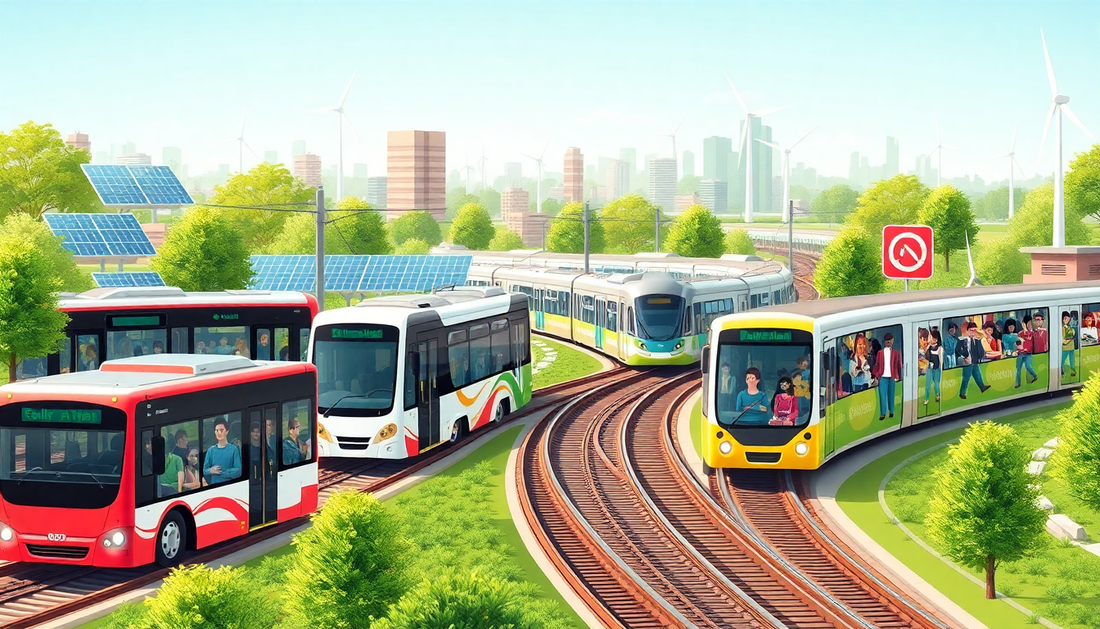In a world increasingly conscious of the need for sustainable living, the role of public transportation in environmental protection has become more crucial than ever before. As cities grapple with the challenges of rising carbon emissions, traffic congestion, and the depletion of natural resources, the shift towards eco-friendly modes of transportation has emerged as a critical strategy for a greener future.
The Environmental Impact of Public Transportation
Public transportation, when utilized effectively, can significantly reduce an individual's carbon footprint and contribute to the overall environmental well-being of a community. By encouraging the use of buses, trains, and other shared modes of travel, public transport effectively minimizes the number of private vehicles on the road, leading to a substantial decrease in greenhouse gas emissions.
According to recent studies, the average passenger-mile emissions for public transportation are significantly lower than those of private vehicles. This is particularly true for modes like electric buses and hybrid transit systems, which harness the power of renewable energy sources and advanced technologies to further reduce their environmental impact.
Eco-Friendly Public Transport Options
As the demand for sustainable transportation solutions grows, cities around the world are investing in a variety of eco-friendly public transport options. Electric buses, for instance, have become increasingly popular, offering a clean and efficient alternative to traditional diesel-powered vehicles. These emission-free buses not only reduce air pollution but also contribute to a quieter urban environment, enhancing the overall quality of life for residents.
In addition to electric buses, many cities are also exploring the potential of hybrid transit systems, which combine the convenience of public transportation with the environmental benefits of renewable energy sources. These systems often integrate solar panels, wind turbines, and other clean energy technologies to power their operations, further reducing their carbon footprint.
Urban Planning and Public Transport
The integration of public transportation into urban planning and design is crucial for maximizing its environmental benefits. By developing infrastructure that prioritizes pedestrian and cyclist-friendly routes, cities can encourage the use of active transportation modes, such as walking and cycling, in conjunction with public transit. This holistic approach to urban mobility not only reduces reliance on private vehicles but also promotes a healthier, more livable community.
Furthermore, the strategic placement of public transport hubs and the optimization of route networks can significantly improve accessibility and convenience for commuters, making it a more attractive option for a wider range of individuals. This, in turn, can lead to a higher adoption rate of public transportation, amplifying its positive impact on the environment.
Economic Benefits of Public Transport
The environmental benefits of public transportation are often accompanied by significant economic advantages for cities and communities. By reducing the need for costly road maintenance and infrastructure development, public transport can help municipalities allocate resources more efficiently, freeing up funds for other essential services and sustainability initiatives.
Moreover, the growth of the public transportation sector can create new job opportunities in areas such as vehicle manufacturing, infrastructure development, and operations management. This economic stimulus can contribute to the overall prosperity of a region, further supporting the transition towards a more sustainable future.
Challenges and Solutions
Despite the numerous benefits of public transportation, there are still challenges that must be addressed to ensure its widespread adoption and long-term sustainability. These challenges may include limited funding for infrastructure development, the perceived convenience of private vehicles, and the need for technological advancements to improve the efficiency and reliability of public transit systems.
To overcome these obstacles, governments, policymakers, and transportation authorities must work collaboratively to implement innovative solutions. This may involve the introduction of financial incentives for public transport users, the implementation of smart city technologies to optimize route planning and real-time information sharing, and the development of comprehensive public awareness campaigns to educate citizens on the environmental and economic advantages of sustainable transportation.
Global Case Studies
Around the world, there are numerous examples of cities and regions that have successfully integrated public transportation into their sustainability strategies, reaping the environmental and economic benefits. In Europe, cities like Copenhagen and Amsterdam have long been recognized for their extensive bicycle infrastructure and integrated public transport networks, which have significantly reduced car usage and emissions.
In Asia, cities like Singapore and Hong Kong have also made significant strides in promoting eco-friendly public transportation. Singapore, for instance, has invested heavily in its Mass Rapid Transit (MRT) system, which has become the backbone of the city's transportation network, while Hong Kong's comprehensive bus and rail systems have contributed to its status as one of the world's most sustainable urban centers.
The Future of Public Transportation
As the global community continues to grapple with the pressing challenges of climate change and environmental degradation, the role of public transportation in shaping a more sustainable future becomes increasingly vital. With the rapid advancements in technology, the emergence of innovative mobility solutions, and the growing public awareness of the need for sustainable living, the potential for public transport to drive positive environmental change is greater than ever before.
In the years to come, we can expect to see a further integration of renewable energy sources, autonomous vehicles, and smart city technologies into public transportation systems, further enhancing their efficiency, accessibility, and environmental impact. Additionally, the development of comprehensive policies and incentives that encourage the use of public transit, coupled with the continued investment in infrastructure and urban planning, will be crucial in ensuring the long-term viability and sustainability of this essential mode of transportation.
Conclusion
As we strive to create a more sustainable and livable world, the role of public transportation cannot be overstated. By reducing carbon emissions, decreasing individual carbon footprints, and promoting a more efficient and eco-friendly urban landscape, public transport has the power to transform the way we move and live. Through a collective effort involving governments, policymakers, transportation authorities, and the public, we can harness the full potential of public transportation to build a greener, more resilient, and more prosperous future for all.

